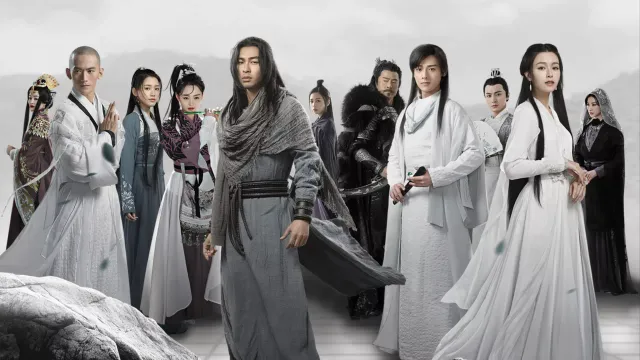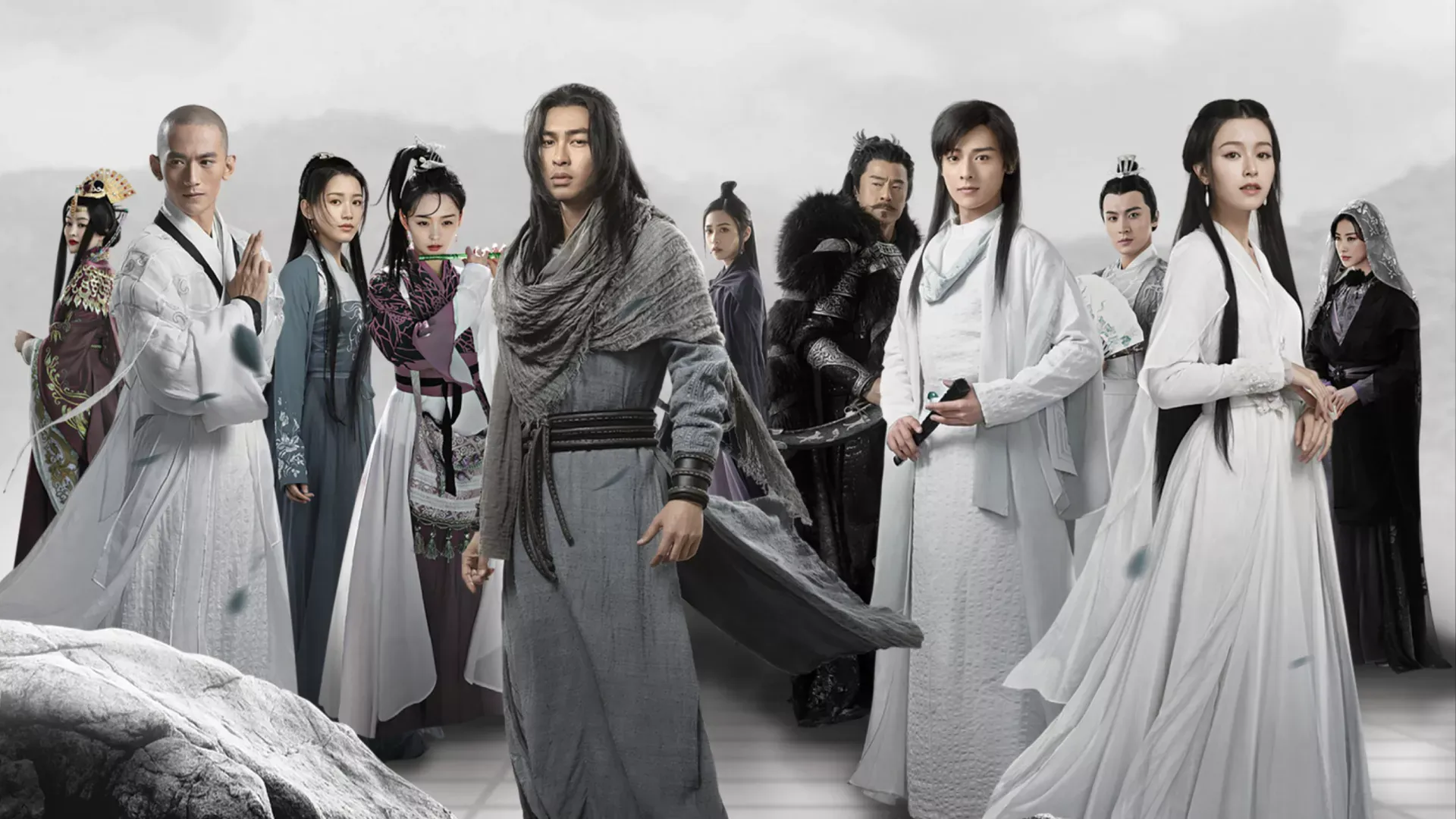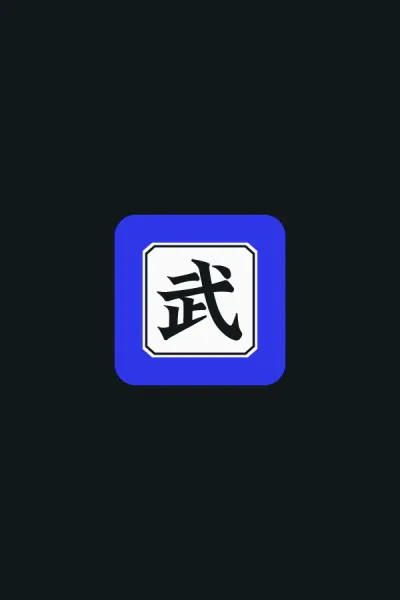Lingjiu Palace (simplified: 灵鹫宫, traditional: 靈鷲宮, pinyin: Língjīu Gōng) was a formidable martial arts organisation hidden deep within Tianshan.1 Despite its remote location on Piaomiao Peak, the palace secretly controlled numerous jianghu factions across central China and the southeastern coast, making it one of the most influential powers in the martial world. The organisation was renowned for its exclusively female membership and fearsome martial arts techniques involving ice and cold.
The palace is named after Gṛdhrakūṭa,2 the mountain in India where Buddha preached the Lotus Sutra.
History
Foundation
According to Lingjiu Palace’s own records, the organisation existed as a mysterious faction that disappeared into history hundreds of years before the Northern Song period.3 The young Xiaoyaozi discovered this ancient site during his travels, later passing it to his eldest disciple, Tianshan Child Granny, who established the current Lingjiu Palace. However, alternative interpretations suggested that the palace existed independently of the Xiaoyao Order entirely, with Tianshan Child Granny occupying the abandoned stronghold and inheriting the title of palace master from an unknown previous organisation.
Stone murals within the palace’s underground chambers contained martial arts secrets left by these founding masters, including techniques that would later become central to the Xiaoyao Order’s teachings. These ancient chambers, with their elaborate tunnel systems and massive stone caverns, required decades of construction and enormous expenditure of labour and materials, far beyond what the current palace residents could have accomplished.
Tianshan Child Granny era
The palace reached its zenith under the rule of Tianshan Child Granny, who began practising the palace’s supreme martial art, Eight Desolations Six Directions Supreme Technique, from the age of six. This technique granted her incredible power but cursed her with a child-like appearance throughout her life.
Under her leadership, Lingjiu Palace expanded its influence by subjugating thirty-six mountain caves and seventy-two island bases, creating a vast network of subordinate factions controlled through the fearsome Mark of Life and Death.
Transfer of Power
Following Tianshan Child Granny’s death from injuries sustained in battle with her former junior Li Qiushui, the palace unexpectedly fell under the control of Xuzhu, a young Shaolin Order monk. This dramatic change in leadership occurred when Tianshan Child Granny, in her final moments, transferred all her martial knowledge and authority to Xuzhu, making him the new master of Lingjiu Palace.
Organisation
Leadership structure
Lingjiu Palace maintained a strict hierarchical structure with the palace master at its apex. Below the master were the Nine Heavenly Divisions (Jiutian Jiubu), each led by senior female disciples. The Nine Divisions were:
- Haotian Division (Haotian Bu) - Led by Elder Yu (Yu Po)
- Yangtian Division (Yangtian Bu) - Administrative affairs
- Chitian Division (Chitian Bu) - Combat specialists
- Zhutian Division (Zhutian Bu) - Responsible for intelligence gathering
- Chengtian Division (Chengtian Bu) - Supply and logistics
- Youtian Division (Youtian Bu) - Internal discipline
- Xuantian Division (Xuantian Bu) - Security and patrol duties
- Luantian Division (Luantian Bu) - Elite guards and external search operations
- Juntian Division (Juntian Bu) - Palace defence and strategic positions
Membership requirements
The palace maintained an exclusively female membership policy, with no men permitted to reside within its walls. New members were typically recruited from those who had suffered at the hands of men, whether through betrayal, abandonment, or family destruction. Under Tianshan Child Granny’s influence, the palace cultivated a deep mistrust of the male gender, viewing men as inherently untrustworthy.
The palace operated as both a fortress and a small city, functioning simultaneously as a marketplace and castle. The extensive residential complex housed hundreds of disciples from diverse backgrounds - while most were Han Chinese from the Central Plains, the palace also peacefully accommodated local ethnic minorities who contributed to the palace’s daily operations. The surrounding area for hundreds of li fell under palace control, creating a peaceful, harmonious environment that had never experienced warfare.
The Four Maids
Four sisters known as Plum Sword, Orchid Sword, Bamboo Sword, and Chrysanthemum Sword served as the palace master’s personal attendants. These quadruplets, abandoned as infants and raised by Tianshan Child Granny, had identical appearances and held unwavering loyalty to their master. They were skilled in martial arts and served as the palace master’s closest confidantes.
Underground chambers
The palace contained extensive underground chambers accessed through hidden passages beneath artificial mountains in the garden area. These tunnels, protected by numerous traps and mechanisms, led to massive stone caverns that followed the mountain’s natural cave systems. The deepest chamber housed the palace’s greatest treasure: hundreds of circular murals carved into the stone walls, each containing martial arts techniques left by previous masters.
These stone wall diagrams were organised with numerical codes such as “Jia 1”, “Jia 2”, “Zi 1”, “Zi 2”, and contained illustrations ranging from human figures and animal forms to incomplete text and abstract symbols. The collection included complete sequences for Tianshan Plum-plucking Hand, Tianshan Six Yang Palms, and advanced techniques that even Xuzhu had not learnt from Tianshan Child Granny. Access to these chambers was traditionally restricted, with even the Four Maids only permitted to study them after age forty and decades of faithful service.
External network
Beyond the palace itself, Lingjiu Palace controlled a vast network of subordinate organisations, including the famous thirty-six mountain caves and seventy-two island bases. These subsidiary factions operated throughout the jianghu under the palace’s authority, bound by the Mark of Life and Death’s commands.
Martial arts abilities
Lingjiu Palace was renowned for several distinctive martial arts techniques:
Eternal Immortality Power
This is the palace’s supreme internal energy method. It allows practitioners to return to childhood and rebuild their martial arts foundation, gaining immense power in the process. Tianshan Child Granny began practising this technique at age six, undergoing returns to childhood at thirty-six, sixty-six, and ninety-six years of age, with each cycle requiring progressively longer recovery periods of thirty, sixty, and ninety days respectively. However, the technique required the practitioner to drink fresh blood daily during the restoration period and left them vulnerable during the transformation. Early practice of this technique caused permanent damage to Tianshan Child Granny’s development, leaving her trapped in a child-like appearance throughout her life.
Tianshan Plum-plucking Hand
This martial art comprises six sets of techniques that incorporate the essence of all martial arts. Despite containing only three palm techniques and three grappling methods, it can adapt and counter any opponent’s techniques, growing more sophisticated as the practitioner’s knowledge expands.
Tianshan Six Yang Palms
This technique combines yin and yang energies in nine distinct palm forms. It serves as the primary method for dispelling the Mark of Life and Death and requires deep understanding of both soft and hard martial principles. Recorded techniques include the second form “Yangchun Baixue” (Spring Snow), the seventh form “Yangguan Sandie” (Yang Pass Three Refrains), and “Yangge Tianjun” (Yang Song Heavenly Sovereign), though the position of the latter in the sequence remains unclear. Each technique incorporates different proportions of yin and yang energy, similar to the Seven Injuries Fist but far more sophisticated in execution.
Mysterious Ice Technique
This technique allows practitioners to create ice from their palms regardless of weather conditions. It works in conjunction with the Ice Gathering Technique to provide the palace’s disciples with their signature ice-based attacks.
Mark of Life and Death
The palace’s most feared technique, the Mark of Life and Death is created by reversing internal energy flow to transform yang energy into yin, making the practitioner’s palm energy several times colder than natural ice. The technique involves infusing liquid (water or wine) with specific combinations of yin and yang energy—such as three parts yang and seven parts yin, or six parts yin and four parts yang—creating infinite variations in the talisman’s effects. Only the creator or someone versed in Tianshan Six Yang Palms combined with the palace’s medical texts can provide relief. Once afflicted, victims experience cycles of escalating itching and pain over eighty-one days, followed by gradual relief, then renewed escalation in an endless cycle that makes death preferable to continued existence.
Tendon-Severing Bone-Corroding Pills
These pills appear to be a variant of the Mark of Life and Death in pill form, manifesting as blood marks at the Tianchi point.
Philosophy
Lingjiu Palace operated under a philosophy shaped by its female-only membership and the experiences of its disciples. The organisation viewed men with deep suspicion, considering them inherently untrustworthy and prone to betrayal. This worldview was reinforced by Tianshan Child Granny’s own experiences and the backgrounds of many palace members who had suffered male-inflicted hardships.
The palace emphasised absolute loyalty to the master and strict adherence to hierarchy. Disciples were expected to show unwavering obedience and were forbidden from questioning their superiors’ commands. This rigid structure extended to the subordinate factions, which were bound by the Mark of Life and Death to serve the palace without rebellion.
Despite its harsh reputation, the palace also embodied certain protective principles, offering sanctuary to women who had nowhere else to turn and providing them with the power to defend themselves against future harm.
Notable Members
Tianshan Child Granny
Tianshan Child Granny ruled the palace for decades, expanding its influence throughout the jianghu. Her mastery of the palace’s supreme martial arts and her ruthless use of the Mark of Life and Death made her one of the most feared figures in the martial world.
Li Qiushui
Though primarily associated with her role as Western Xia’s Imperial Concubine, Li Qiushui maintained connections to Lingjiu Palace through her Xiaoyao Sect background and her relationship with the palace’s martial arts traditions.
The Four Maids
Four sisters known as Plum Sword, Orchid Sword, Bamboo Sword, and Chrysanthemum Sword served as the palace master’s personal attendants. These quadruplets, abandoned as infants and raised by Tianshan Child Granny, had identical appearances and held unwavering loyalty to their master. They were skilled in martial arts and served as the palace master’s closest confidantes.
Xuzhu
Despite his Buddhist background and initial reluctance, Xuzhu became the palace’s master after receiving Tianshan Child Granny’s final transmission of knowledge and authority.
Relationships
Alliances
Under Xuzhu’s leadership, Lingjiu Palace developed friendly relations with several major factions. The palace maintained cordial ties with the Shaolin Order, despite-order’s complicated relationship with his former monastery. Strong bonds existed with the Dali Kingdom through Xuzhu’s sworn brotherhood with Duan Yu, and with the Beggar’s Sect through his relationship with Xiao Feng.
Vassals
The palace commanded absolute loyalty from its extensive network of subsidiary organisations. The thirty-six mountain caves and seventy-two island bases operated under direct palace authority, their leaders bound by the Mark of Life and Death to prevent rebellion. These included groups like the Divine Farmer Gang and various smaller martial arts schools throughout southern China.
Historical rivalries
Traditional enemies included the Xiaoyao Sect’s internal conflicts, particularly the rivalry between Tianshan Child Granny and Li Qiushui. The palace also faced challenges from those seeking to break free from the Mark of Life and Death’s control, leading to periodic rebellions among subordinate factions.
Locations
Headquarters
Piaomiao Peak served as the palace’s primary stronghold, located in the southern foothills of the Tianshan, west of the Western Xia capital. Despite its name suggesting a misty, ethereal location, the peak actually occupied a warm, humid valley rather than a snow-covered summit. The peak’s moderate elevation meant it lacked snow and ice, instead being shrouded in mist for approximately half the year, which gave rise to its name meaning “Piaomiao Peak.”
The natural environment provided several advantages to the palace. Abundant cold springs from the snow mountains served dual purposes: they could be transformed into the mysterious ice weapons used by palace disciples, and they proved ideal for irrigation, producing grapes that were exceptionally sweet, thick-fleshed, and juicy. Though Tianshan produced valuable snow lotus flowers, reaching the snow-capped peaks from Piaomiao Peak remained a treacherous and dangerous journey.
The palace complex functioned as both a fortress and a small city, housing hundreds of disciples and controlling the surrounding area for miles in every direction. The palace featured extensive underground chambers containing ancient stone murals that recorded advanced martial arts techniques. These chambers served as both repositories of knowledge and training grounds for disciples seeking to master the palace’s most sophisticated martial arts.
Strategic positions
The palace maintained watchtowers and defensive positions throughout the Tianshan region, including the famous Jietian Bridge—a single iron chain spanning a deep gorge that served as the primary access route to the palace. This bridge could be severed in times of danger, effectively isolating the palace from attack.
External bases
Through its network of subordinate factions, Lingjiu Palace maintained influence in locations ranging from the Central Plains to the southeastern coast. These positions allowed the palace to gather intelligence, control trade routes, and project power far beyond its mountain stronghold.
Special features
Yu Diao (Imperial Eagles): The palace maintained large eagles called Lingjiu, from which the palace derived its name. These distinctive birds had short wings and broad talons, making them better suited for running than flying. The presence of these eagles contributed to the palace’s mystique and provided both practical and symbolic significance to the organisation.
Behind the scenes
Lingjiu Palace serves as one of Jin Yong’s most intriguing explorations of female power and agency in the jianghu. The organisation’s exclusively female membership and its members’ shared experiences of male-inflicted trauma create a unique social dynamic within the martial world. The palace represents both sanctuary and prison - offering protection and power to its members while demanding absolute loyalty and conformity.
The transfer of the palace from Tianshan Child Granny to Xuzhu represents a significant thematic shift in the novel, highlighting themes of redemption, unexpected leadership, and the possibility of change within even the most rigid organisations. Xuzhu’s transformation from humble monk to palace master embodies the novel’s exploration of fate, identity, and moral complexity.
The palace’s martial arts, particularly the Mark of Life and Death, serve as metaphors for control and dependence, illustrating how power can be both liberating and enslaving. The organisation’s ultimate evolution under Xuzhu’s more compassionate leadership suggests possibilities for reform and growth within traditional power structures.
See also
Footnotes
-
天山 – Tiān Shān. Literally heaven mountain. Central Asian range dividing Xinjiang. See Wikipedia. ↩
-
灵鹫山 – Língjìu Shān. Vulture Peak, also Known as the Holy Eagle Peak. See Wikipedia. ↩
-
北宋 – Běi Sòng. Period of the Song Dynasty that lasted from 960 to 1127 CE, with its capital in Bianjing, modern-day Kaifeng. See Wikipedia. ↩


